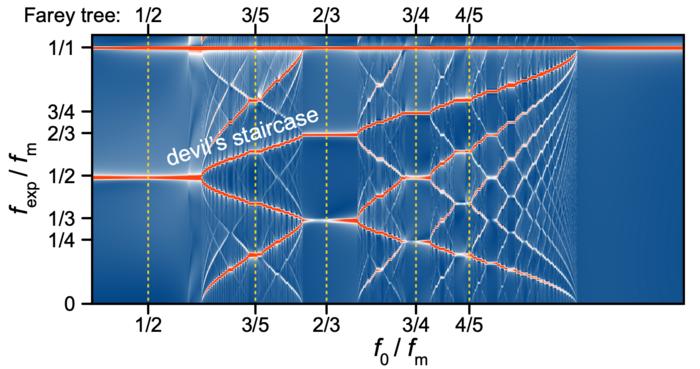Physicists at TU Dortmund University have recently made groundbreaking advancements in the study of time crystals, showcasing a variety of nonlinear dynamic phenomena that challenge our understanding of synchronization and chaos. Their research, featured in the esteemed journal Nature Communications, has unveiled a remarkable interplay between periodic driving and the inherent properties of a semiconductor material, leading to insights that could transform our knowledge of complex dynamical systems.
Time crystals, first conceptualized in 2012, represent a unique phase of matter that exhibits periodic motion in its ground state. They operate under continuous drive conditions, defying conventional thermodynamic principles. In a significant leap forward, Dr. Alex Greilich and his team have utilized a highly robust time crystal, made from indium gallium arsenide, to investigate the dynamic regimes achievable through periodic illumination. By applying bursts of laser light to the crystal, they have demonstrated that it can achieve perfect synchronization under specific conditions while exhibiting chaotic behavior at other points within the same semiconductor structure.
The team’s novel approach involved periodically illuminating the time crystal rather than maintaining a constant laser focus. This method allowed the researchers to observe a diverse range of frequencies and responses from the system, illuminating its proclivity for both order and chaos. The findings reveal an astonishing spectrum of dynamical behaviors as they finely tune the modulation frequency of the laser. This exploration has culminated in a visual representation that clearly delineates the system’s frequency response, revealing areas of synchronization that align precisely at certain fractions of the crystal’s natural frequency.
The Farey tree sequence, a mathematical construct that organizes fractions in a unique hierarchical structure, came to life within the crystal’s response patterns. This sequence manifests in the observed phase transitions, suggesting a novel approach to understanding synchronization phenomena in time crystals. The presence of such intricate relationships signifies a profound achievement, as it marks the first time these mathematical constructs have been realized in a physical system, providing a tangible bridge between abstract mathematical theory and empirical observation.
With the modulation frequency adjusted further, the researchers encountered the end of the synchronization range, where a fascinating branching behavior commenced. Each frequency component visibly bifurcates into symmetrical branches around the synchronization point—the emergence of a structure resembling a staircase, termed the "devil’s staircase.” This phenomenon elucidates the interconnectedness of frequency components, revealing that they not only connect unique synchronization plateaus but also exhibit intricate dynamics as they evolve into chaotic behavior with the slightest perturbation in the driving frequency.
The importance of these dynamic observations cannot be overstated. Each phase of the time crystal’s response offers insights into how slight changes in driving conditions can lead to drastically different motion forms. The chaos identified in this system does not equate to a complete loss of predictability; rather, it highlights the sensitivity of the system’s response to external alterations. Understanding these dynamics helps us decipher complex systems across various scientific disciplines, from physics to biology, where similar nonlinear behaviors prevail.
Greilich describes these findings as pivotal for advancing our comprehensive grasp of nonlinear systems. The team’s continued research aims to further unravel the intricate relationship between complex dynamic states and external periodic drives. This endeavor not only paves the way for theoretical advancements but also has practical implications for semiconductor technologies that underpin modern electronics and information systems.
The exploration of nonlinear dynamics in periodically driven systems also beckons relevance in multiple biological contexts. For instance, phenomena such as heartbeats are governed by similar principles of synchronization and chaos. Understanding these dynamics in engineered systems could enhance our comprehension of biological processes, potentially influencing fields as diverse as bioengineering and neuromodulation strategies.
As the researchers delve deeper into the chaotic realms of time crystals, they anticipate that future investigations will yield additional insights into how these dynamic states arise and their implications for a broad spectrum of applications. The cross-disciplinary nature of their findings illustrates the vast potential of nonlinear systems in deciphering complex behaviors that permeate both natural and engineered environments.
This research adds a significant chapter to the ongoing narrative of time crystal investigations, reinforcing the importance of combining theoretical models with experimental validity. The implications of this research extend far beyond the confines of a laboratory, touching on fundamental principles that could reshape how we approach and understand challenges in various scientific domains. As physicists continue to unlock the mysteries of time crystals, we stand on the cusp of a new era in the study of dynamics in disordered and ordered systems alike.
The trajectory set by Greilich and his team invites anticipation for what the future might hold within the realms of time crystals and chaotic dynamics. These insights not only push the boundaries of our current scientific paradigms but also establish a collaborative foundation for further interdisciplinary explorations.
Continuous investigations in this field could potentially lead to enhanced methods for controlling semiconductor properties that are essential for advancements in electronics, quantum computing, and beyond. The integration of findings from nonlinear dynamics into practical applications illustrates the perpetual interdependence of scientific inquiry and technological innovation, reaffirming the significance of research endeavors that seek to unravel the complexity of the universe.
As the journey into the enigmatic world of time crystals unfolds, Dr. Alex Greilich and his team exemplify the spirit of discovery that fuels scientific progress. Their commitment to exploring the nuances of nonlinear systems ensures that the quest for knowledge remains vibrant, opening doors to uncharted territories of understanding, innovation, and application that will resonate for generations to come.
Subject of Research: Nonlinear dynamics in periodically driven time crystal
Article Title: Exploring nonlinear dynamics in periodically driven time crystal from synchronization to chaotic motion
News Publication Date: March 26, 2025
Web References: Link to journal
References: None available
Image Credits: Credit: Dr. Alex Greilich
Keywords
Nonlinear dynamics, time crystals, periodic driving, chaos, synchronization, semiconductor physics, Farey tree sequence, devil’s staircase.




